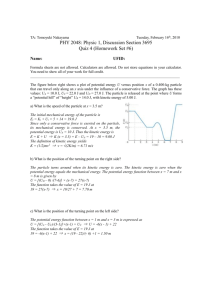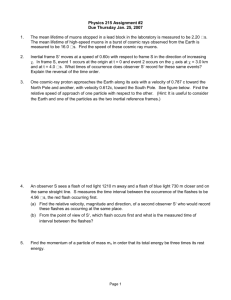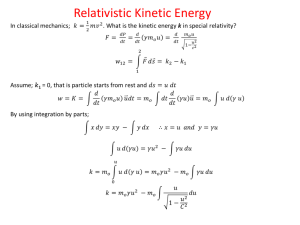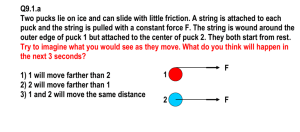Chapter 9 Notes
advertisement
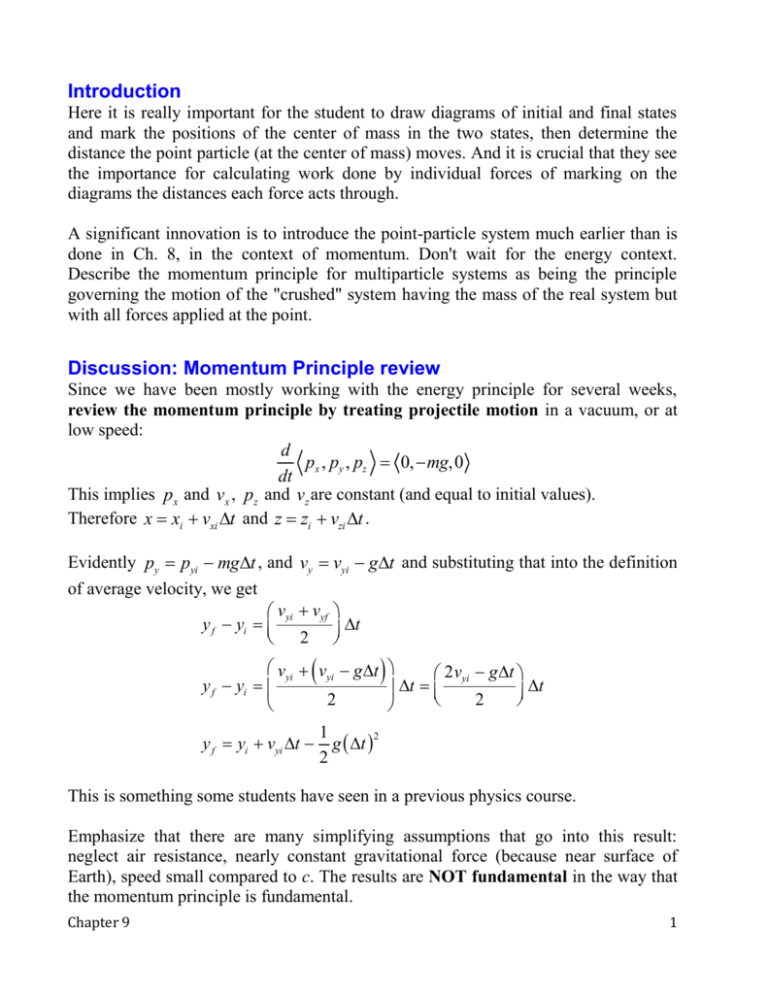
Introduction Here it is really important for the student to draw diagrams of initial and final states and mark the positions of the center of mass in the two states, then determine the distance the point particle (at the center of mass) moves. And it is crucial that they see the importance for calculating work done by individual forces of marking on the diagrams the distances each force acts through. A significant innovation is to introduce the point-particle system much earlier than is done in Ch. 8, in the context of momentum. Don't wait for the energy context. Describe the momentum principle for multiparticle systems as being the principle governing the motion of the "crushed" system having the mass of the real system but with all forces applied at the point. Discussion: Momentum Principle review Since we have been mostly working with the energy principle for several weeks, review the momentum principle by treating projectile motion in a vacuum, or at low speed: d px , py , pz = 0, -mg, 0 dt This implies px and vx , pz and vz are constant (and equal to initial values). Therefore x = xi + vxi Dt and z = zi + vzi Dt . Evidently py = pyi - mgDt , and vy = vyi - gDt and substituting that into the definition of average velocity, we get æ vyi + vyf ö y f - yi = ç Dt è 2 ÷ø ( ) æ vyi + vyi - gDt ö æ 2vyi - gDt ö y f - yi = ç ÷ Dt = ç ÷ø Dt 2 2 è è ø y f = yi + vyi Dt - 1 2 g ( Dt ) 2 This is something some students have seen in a previous physics course. Emphasize that there are many simplifying assumptions that go into this result: neglect air resistance, nearly constant gravitational force (because near surface of Earth), speed small compared to c. The results are NOT fundamental in the way that the momentum principle is fundamental. Chapter 9 1 Discussion: Center of mass review Remind students that the rate of change of total momentum is equal to the net force, exactly as for a point particle (comment that proof is in book, depends on cancellation of forces internal to the system). Definition of center of mass position velocity of center of mass total momentum P_total = Mv_cm State without proof that the total momentum (v << c) can be expressed as the total mass times the velocity of the center of mass point. Comment that there is a formula for calculating the center of mass of an arbitrarily complicated object, but we’ll only actually deal with situations where the center of mass is obvious (center of a sphere, etc.). Show just for orientation two equal spheres a distance apart, ask for center of mass; then ask where the center of mass would be (qualitatively) if one of the spheres has much more mass than the other. Demo: Motion of multiparticle systems Earth-Moon_system.mov, Fireworks.mov, Pencil.mov What if the projectile isn’t a point particle but some blobby floppy thing? Throw a floppy thing and observe that in some sense the floppy object follows the same kind of trajectory. Show movies of fireworks, pencil, Earth/Moon and baseball bat. It is the “center of mass” that follows the point-like trajectory, with other internal motions relative to that center of mass. Why is this? Have a, b, c groups describe movies as I display their laptop screen? (Group A: Moon, Group B: pencil, Group C: Fireworks). Little time at end, we discussed what Fnet was for each system and how it predicted v_cm. Ponderable: Two pucks Clickers Q91a, b 09_twopucks.py TwoPucksDemo.rm Like example in book, but with more detail. Have even tables do point particle system. Odd tables to real system. Two identical pucks pulled on ice, with same force for same amount of time. Center of mass of 1 and 2 will move the same distance, d, and L string will unwind from puck 1. Chapter 9 2 L+d 1 x 2 x x F F x F Use GOAL protocol Point particle system: F d L dC L M DEpoint particle system = DK translation = W + Q DK translation = Fnet external dCM Real system: DEreal system = DK total = W + Q ( DK translation + DK rotation = F Lpoint of application + dCM ) So combining the two analyses: DK rotation = FLpoint of application The key point is that it matters whether you calculate the work done by an individual force acting through the individual displacement of its point of application, or the work done (on the point particle system) by the net force through the displacement of the center of mass. Having gotten at the issues, now show the movie. In the version of this physical demo built at NCSU (and shown in the video), massive pulleys are mounted on PASCO carts and pulled by strings that pass over pulleys in such a way that, neglecting rotational inertia, the forces applied to the rotating and nonrotating “pucks” are the same. When things work right, the centers of the two systems move together, as predicted by the multiparticle version of the momentum principle. Tapes attached to the string let you see that the force acting on the rotating puck moves through a distance about 3 times that of the force acting on the nonrotation puck, so that if the nonrotating puck gets 10 J of (translational) kinetic energy, the rotating puck gets 30 J of kinetic energy, 10 J translational and 20 J rotational. Chapter 9 3 VPython Demo: Relative velocity 09_kRel.py (first) with Clickers Q9.1a , Q9.1b, Q9.2a 09_RotateVibrateTranslate.py (second) with Q92b-h Talk briefly about v_cm and v_relative. v_relative is what you see from your POV if you are “riding along” with the center of mass. Relate to the fireworks video. Clickers 9.3a, 9.3b, 9.3a Discussion: Translational kinetic energy So the momentum principle holds for the motion of the center of mass of arbitrarily complicated objects. This is why our analysis of a point particle projectile is also fine for the center of mass of a floppy object. What we’ve just seen in the motion of the ball and the floppy object makes these results plausible. It can be useful to think in terms of Superman crushing the actual system of interest down to a point particle located at the center of mass, having the mass of the actual system, and subjected to the same net force as the actual system. The motion of this “point particle system” will be the same as the motion of the center of mass of the 2 actual system. The kinetic energy of the point particle 12 M total vCM is called “translational kinetic energy.” So you know from the familiar momentum principle applied to the point particle system something about the way a complicated multiparticle system will move. What about the motion relative to the center of mass? The rotation, vibration and general floppiness of the system? The last property of multiparticle systems that we need is that if you add up the kinetic energy of every atom, which we naturally call the total kinetic energy of the system, it turns out that this is numerically equal to the kinetic energy of the point particle 2 system 12 M total vCM plus the kinetic energy relative to the center of mass, involving speeds relative to the center of mass. Ktot = Ktrans + Krel Simple example: a nonrotating but “translating” wheel has kinetic energy equal to the translational kinetic energy. If it rotates without translating it has “rotational” kinetic energy, associated with speeds relative to the center. If the wheel rotates while it translates the two terms simply add to give the total kinetic energy, which is equal to the total kinetic energy of all the atoms. The fact that kinetic energy splits up this way sounds plausible but the proof is rather difficult; the proof is given in an appendix to Ch 8. Chapter 9 4 Ponderable: Activity - 2-particle system WID 1156844 twoparts Consider a 2-particle system like this: 1) mass 2 kg, velocity < 3, 5, 0 > m/s 2) mass 3 kg, velocity < -4, 2, 0 > m/s Have students use whiteboards to sketch situation and then calculate the total momentum: < 6, 10, 0 > kg m/s + < -12, 6, 0 > kg m/s = < -6, 16, 0 > kg m/s. This is equal to total mass times cm velocity, so students calculate velocity of the center of mass: Ptot » Mvcm -6,16, 0 kg×m Ptot s vcm = = = -1.2, 3.2, 0 ms , which looks plausible when drawn. M 5 kg They calculate Ktot = .5(2)(32+52)+.5(3)((-4)2+22) = 64 J They calculate Ktrans = Ptot2/2m = (62+ 162)/(2*5) = 29.2 J or ½ mtot vcm2 (They’ll probably need some guidance here.) They calculate Krel = 34.8 J. Ktot = Ktrans + Krel (Calculating Krel directly of course requires getting the velocities relative to the center of mass and then finding the corresponding kinetic energies. This is a check on getting Krel by subtraction. Unfortunately it requires saying something about relative velocities, which is not a topic we’ve covered.) Ponderable: Skater vs. wall Clickers Q9.4f-g (Like example in book, but with more detail) Skater pushes against wall with force F, moving cm distance d. P > 0 although external work done is zero! Use GOAL protocol and divide up by even/odd tables again, but have even tables do the real system this time. Chapter 9 5 System is skater (real system gives info about internals) E f - Ei = Wexternal + Q = 0 ( mc 2 ) ( d ) + K f + Einternal, f - mc 2 + K i + Einternal, i = 0 K f = Einternal, i - Einternal, f = -DEinternal Since K f > 0, Einternal, i - Einternal, f > 0, so Einternal, i > Einternal, f System is point particle (gives info about cm motion) E f - Ei = Wexternal + Q = Wexternal ( mc 2 ) ( ) d + K cm, f - mc 2 + K cm i = Fdcm K cm, f = Fdcm So K cm, f = Fdcm = -DEinternal d Ponderable: Activity - Two disks colliding WID 1157010 (Problem 9.P.40) dragon d-b b x x F “extra distance” gives “extra work” F d initial final a) Since we are interested just in the speed v of the stuck-together disks, which is also the speed of their center of mass, we should consider the point-particle system. The center of mass of the two-disk system moves a distance b, so we have this: Chapter 9 6 DK trans = Fnet, x DxCM = Fb (point-particle system) 1 ( 2M ) v 2 - 0 = Fb 2 Fb v= M b) Consider the real system of the two disks. You do an amount of work Fd, and the main energy change is the translational kinetic energy and the thermal energy: DK trans + DEthermal = Fd (real system) Fb + DEthermal = Fd DEthermal = F ( d - b ) This is positive, corresponding to the fact that the temperature of the two disks rises. Clickers Q9.4a-h Lab: Jumping up WID 628636 yump Students apply energy and momentum principle to the real and point particle system for a person jumping in the air from a crouching position. 3.1 DK tran + DEinternal = F floor × Dr floor + F Earth × Dr CM 0 + DEinternal = 0 + mg(y3 - y1 )cos180 = -862J Chapter 9 7 DK tran = F net × Dr CM 3.2 DK tran = mg(y3 - y2 )cos180 = -431J v2 = 3.3 3.3 2(431) = 2.8 ms m DK tran = F net × Dr CM +431 J = ( Ffloor - mg) (y2 - y1 ) = 2156 N » 540 lb DK tran = F net × Dr CM +431 J = ( Ffloor - mg) (y2 - y1 ) = 2156 N » 540 lb D p = F net Dt 3.4 mv2 = ( Ffloor - mg ) Dt Dt = 110(2.8) = 0.29 s (2156 -110 * 9.8) Ponderable: Activity - Spring and two masses WID 1156913 (Problem 9.P.44 – used in M&I labs) boing Encourage students to use the following process: Draw diagrams of initial and final state of the point particle system o Include all forces acting on the system o Every force should act on the center of mass Write Energy Principle for the point particle system Draw diagrams of initial and final state of the real system o Include all forces acting on the system Calculate the work from each force Write Energy Principle for the real system Use ∆Ktrans from point particle system in real system You hold up an object that consists of two blocks at rest, each of mass M = 5 kg, connected by a low-mass spring. Then you suddenly start applying a larger upward force, of constant magnitude F = 157 N (which is greater than 2Mg). The diagram shows the situation some time later, when the blocks have moved upward, and the spring stretch has increased. The heights of the centers of the two blocks are as follows: Initial and final positions of block 1: y1i = 0.3 m, y1f = 0.4 m Chapter 9 8 Initial and final positions of block 2: y2i = 0.7 m, y2f = 1.0 m It helps to show these heights on a diagram. Note that the initial center of mass of the two blocks is (y1i + y2i)/2, and the final center of mass of the two blocks is (y1f + y2f)/2. (a) Consider the point particle system corresponding to the two blocks and the spring. Calculate the increase in the total translational kinetic energy of the two blocks. It is important to draw a diagram showing all of the forces that are acting, and through what distance each force acts. DEpoint particle system = W + Q DK translation = Fnet external iDrCM æ y1f + y2 f y1i + y2i ö = Fnet, y yCM, f - yCM, i = (F - Fgrav ) ç 2 2 ÷ø è ( ( ) ( = 157 N - 2 ( 5 kg ) 9.8 m s2 )) æçè 0.4 2+ 1.0 - 0.3 +2 0.7 ö÷ø = (157 N - 98 N ) ( 0.7 m - 0.5 m ) = ( 59 N ) ( 0.2 m ) DK translation = 11.8 J Many students have difficulty with calculating center of mass because they confuse which height is which (diagrams are helpful). For Fgrav , check that students are using 2M (mass of both blocks) instead of M (mass of only one block). (b) Consider the real system corresponding to the two blocks and the spring. Calculate the increase of (Kvib+Us), the vibrational kinetic energy of the two blocks (their kinetic energy relative to the center of mass) plus the potential energy of the spring. It is important to draw a diagram showing all of the forces that are acting, and through what distance each force acts. DEreal system = W + Q DK total = å F1 iDr1 + F2 iDr2 + ... DK translation + DK vibration + DUspring = FDy2 + Fgrav DyCM Chapter 9 9 ( ) ( ) DK vibration + DU spring = F y2 f - y2i - 2Mg yCM, f - yCM, i - DK translation = (157 N ) (1.0 m - 0.7 m ) - ( 98 N ) ( 0.2 m ) - 11.8 J = 47.1 J - 19.6 J - 11.8 J DK vibration + DU spring = 15.7 J The biggest confusion is in the fact that in the real system, the forces move through different displacements Chapter 9 10
